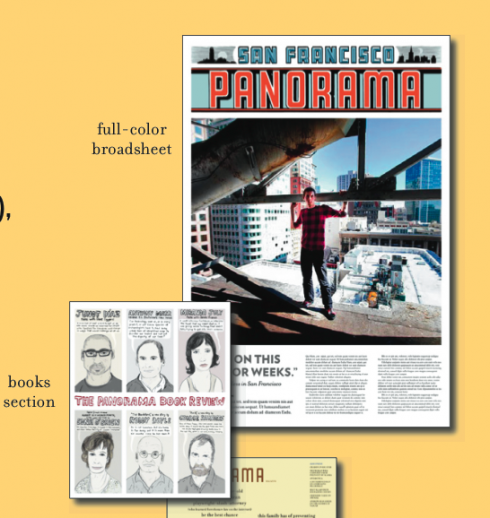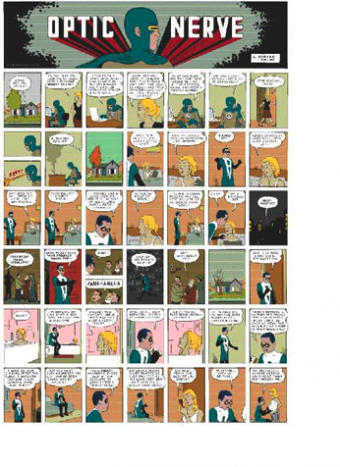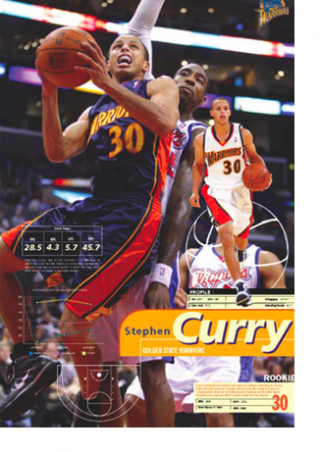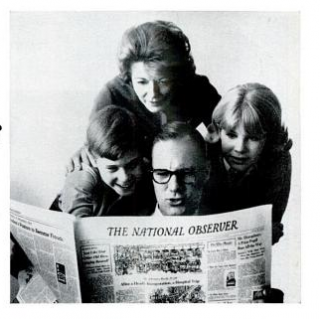TAKEAWAY: Novelist Dave Eggers thinks that printed newspapers deserve the chance to stay around for years to come. He is showing it to the world with publication of San Francisco Panorama. It is a big undertaking, including some of the writers whose bylines appear in Vol. 1, No. 1 of Panorama.
Why print matters!

Something retro about this newspaper logo is quite appropriate for a project that resonates with nostalgia

View of Panorama’s front page from publicity package

The big graphics are part of Panorama

The comics page, big and colorful, like in the old days. A large comics section featuring the work of Chris Ware and Art Spiegelman, among others

The sports poster tucked inside Panorama
He may not rush in as saviour of printed newspapers, and perhaps that is not his intent, but novelist Dave Eggers has something grander——indeed, big——that he is publishing to remind the world of the goodies that a printed newspaper may offer.
And a grand project, it is. Panorama is the new issue of McSweeney’s quarterly review.
I was recently introduced to Panorama by our year-round intern, Reed Reibstein (Yale University ‘11) who discovered it probably while escaping from end of the semester research papers and exams.
Big is beautiful
Eggers is not at all concerned that the “trend” for newspaper formats is compact or smaller. In fact, Eggers declared in an interview that “big is beautifuil”.
His “newspaper”, a one-time publication, follows a format from yesteryear. The pages of Panorama are 15 x 22 inches. Forget narrow web, Berliner or tabloid sizes here. It has to be big, and land in the hands of the reader like a big sunami of type, photos, color and graphics, at a price of $16.
The content may be worth it, however. Think of the piece by Stephen King – a Red Sox fan who views the New York Yankees with what he describes as “fear and loathing” — reporting from Baseball City, where the World Series takes place.
Novelist Andrew Sean Greer goes to Michigan to experience NASCAR firsthand.
Among the centerpieces of the Panorama is a robust investigative piece by two-time Pulitzer Prize winner Bob Porterfield, looking into cost overruns in the renovation of the San Francisco-Oakland Bay Bridge. This article a dream that a true city editor of another newspaper era would have assigned with zest.
It appears that one of Eggers’ motives is to have people in the newspaper industry take a look at his experiment and reflect. Here is a quote from his interview with Oscar Villalon, publisher of McSweeney.
What we’re doing is an example of a Sunday newspaper. But the larger question is one the newspaper industry has to ask themselves: Is it worth coming out every single day? Do you keep an online presence for the daily and then you put out a newspaper once a week, twice a week, three times a week, depending on advertising support and depending on what staffing can support?
Memories of the National Observer

This photo appeared in an ad from the National Observer as displayed in LIFE Magazine (Aug. 12, 1966) when the new weekly newspaper promoted its 25-week subscription for $2.67, less than 11 cents per copy. The ad’s copy portrayed the new Observer as “authoritative, wholesome and unslanted…..” with testimonial from a subscriber who described the content “written so interestingly that when I finish an issue the information is mine”
I confess I have not seen a copy of Panorama yet, but I am eager to do so. From the images I see here, I immediately bring to mind the National Observer, a weekly American newspaper published by Dow Jones & Company from 1962 until 1977, and which was one of my favorite reads from the time I was a senior in high school. Writers such as Hunter S. Thompson wrote several articles for the National Observer as the correspondent for Latin America early in his career. It was an in depth newspaper, in a large broadsheet format (all black and white, of course), with great photos and some pioneering efforts in info graphics. Everything was big and splashy in the Observer, but so were the articles, and the people whose bylines appeared on most pages. I waited eagerly for each edition of the Observer to arrive, knowing that I would keep it for a few days, reading one piece at a time.
Panorama also has the content flair that we see weekly in Germany’s Die Zeit, one of that country’s most successful newspapers. People come to Die Zeit to read. Photos and illustrations are part of the treat Die Zeit offers its loyal readers. I have always felt that Die Zeit offers us a possible formula for the printed newspaper of the future: journalistically robust, a sanctuary for reading good stuff written by renowned writers, with a sense of classic design, the attributes of a good book—-and published once a week. Die Zeit is also the closest we come anywhere in the world as “the newspaper as a luxury item”.
Panorama may hint of the same, perhaps becoming, as Reed Reibstein put it to me: a harbinger of the newspaper of the future as a luxury item.
Let’s keep an eye on Panorama.
Don’t miss an interview of Eggers with the Los Angeles TImes about his newspaper project.
For the publicity packet, go here: http://www.mcsweeneys.net/SFPanoramaPR.html
In case the IRS is reading TheMarioBlog
Rumors and blogs.. It is all part of the territory.
While in Bucharest for the early part of this week, working with the daily Romania Libera, a Romanian media blog mentioned my visit to the newspaper, and added that “Garcia has been paid half a million euros for his consultations with RL”.
(Please add loud laugh track here, pronto)
All I can say is how much I wish this blogger had the correct information. But, unless he has seen a contract that I have not seen or signed, the amount quoted is far from the reality of the fee.
If the Internal Revenue Service is reading these blogs, I just want to make sure you folks understand that this is NOT true, much to my chagrin.
But, if the IRS is reading, perhaps they already know that one of my projects, Philadelphia, brings in $1—-so maybe I can get some deduction from my taxes for that effort.
As one of the Romania Libera editors asked me, after telling me that a blogger had turned me into a very rich man overnight: “How do you cope with the many rumors that crop up on blogs everywhere, but especially in the media?”
You ignore it. You laugh and continue doing your work. But, more importantly, you don’t “feed” the rumor mill by answering or reacting. That way, you minimize the journey of the rumor. IT is amazing how these things go away just as quickly as they appear.
For now, I am not buying that beautiful studio apartment overlooking New York City’s Central Park that I have an eye on.
TheMarioBlog post #434